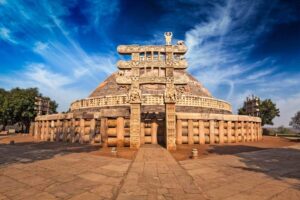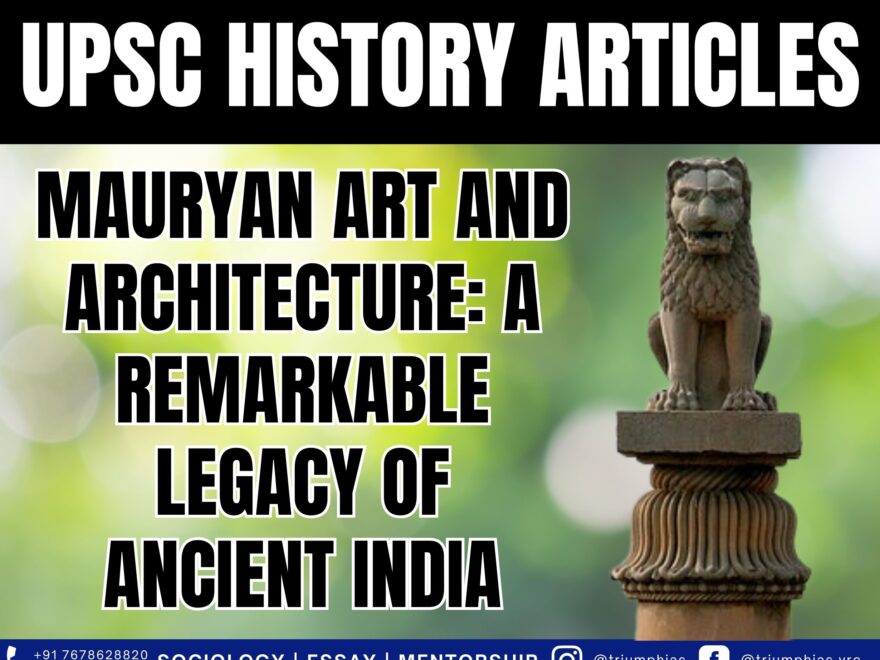Mauryan art and architecture
(Relevant for Historical Section of General Studies Paper Prelims/Mains)

The renowned Mauryan monarch, Ashoka, adopted Buddhism as a component of the shraman tradition, and the extensive missionary efforts of Buddhism during his reign significantly contributed to the evolution of Mauryan sculptural and architectural forms.
During the 3rd century BCE, King Ashoka supported the shraman tradition.
The shraman tradition encompasses various Indian religious movements that existed alongside, yet distinct from, the traditional Vedic religion. This category includes Jainism, Buddhism, as well as other movements like Ajivikas and Carvakas.
Background
- In 321 BC, Chandragupta Maurya, aided by Chanakya (the author of Arthashastra), established the Mauryan dynasty by overthrowing the Nanda Dynasty.
- The Mauryan Empire stands as the first and most potent Indian realm that united the entire Indian subcontinent under a single rule.
- Under the leadership of Chandragupta Maurya, the boundaries of the Mauryan empire extended into Central Asia and Persia.
- Expansion of the Mauryan Empire: Following Chandragupta Maurya, his son Bindusara assumed power in 298 BC and expanded the realm across the majority of present-day India, with the exception of Kalinga.
- Mauryan Dynasty during Ashoka’s Reign: The kingdom of Bindusara was inherited by his son Ashoka the Great in 274 BC.
- Invasion of Kalinga: During the Kalinga campaign, Ashoka underwent a transformation, renouncing violence and adopting the principles of Ahimsa (non-violence) and Buddhism.
Mauryan Art and Architecture
Mauryan Art: Implies architectural works (in the form of pillars, stupas and palaces) commissioned by Mauryan rulers for political as well as religious reasons.
Palaces
- The renowned Greek historian Megasthenes marvelled at the palatial structures of the Mauryan empire, considering them among the most remarkable achievements of human civilization. Similarly, the Chinese traveller Fa Hien referred to Mauryan palaces as divine wonders.
- Influenced by Persian architecture: Chandragupta Maurya’s palace design drew inspiration from the Achaemenid palaces of Persepolis in Iran.
- Choice of materials: Wood constituted the primary construction material employed during the Mauryan Empire.
- Illustrations: Notable instances include the Mauryan capital at Pataliputra, Ashoka’s palace at Kumrahar, and Chandragupta Maurya’s palace.
Pillars
Ashoka pillars, often crafted from Chunar sandstone, held immense significance as symbols of the state within the Mauryan Empire.
Purpose: The primary aim was to propagate Buddhist ideology and the decrees of the court throughout the expanse of the Mauryan domain.
Language: While the majority of Ashoka pillar inscriptions were in Pali and Prakrit languages, a few were also composed in Greek or Aramaic.
Architectural Elements: Mauryan pillars featured four key components:
- Shaft: The base consisted of a lengthy shaft constructed from a single piece of stone, forming a monolith.
- Capital: Positioned atop the shaft, the capital came in either a lotus or bell shape.
- Abacus: Above the capital, a circular or rectangular base known as the abacus was situated.
- Capital Figure: The capital figures, often depicting animals like bulls, lions, and elephants, were dynamic and sculpted to stand on a square or circular abacus.
Similarities with Persian (Achamenian) Pillars
- Refined Stones and Decorative Patterns: The employment of polished stones and the presence of shared sculptural motifs like the lotus can be observed in both Mauryan and Achaemenid pillars.
- Announcements: The concept of engraving proclamations (pertaining to Buddhist teachings and court decrees) onto pillars, as practiced by the Mauryan Empire, draws inspiration from Persian pillar inscriptions.
- Shift in Perspective: The inscriptions of both empires initiate in the third person and subsequently transition to the first person.
Differences with Persian (Achamenian) Pillars
- The Capital Figure: The elaborate capital figures seen in Persepolis pillars are absent in the Mauryan pillars of the Kumhrar hall.
- Shape and Decoration: The shape of the Mauryan lotus differs from that of the Persian pillars.
- Pillar Surface: While most Persian pillars exhibit a fluted or ridged surface, Mauryan pillars have a smooth surface.
- Architectural Design: Achaemenid pillars are typically incorporated into larger architectural schemes, often being complex and intricate. In contrast, Ashokan pillars are simple, freestanding structures.
- Shaft: Unlike the Mauryan shafts, which are constructed from a single piece of stone (monolith), Persian or Achaemenid shafts consist of separate segments of stones stacked on top of one another.
STUPAS
Stupas, which were prevalent in India since the Vedic period, were burial mounds with a significant architectural presence.
Architectural Structure: Stupas feature a cylindrical drum, a circular “anda,” a “harmika,” and a “chhatra” atop.
- Anda: The hemispherical mound symbolizes the dirt mound used to cover Buddha’s remains, with many stupas containing actual relics.
- Harmika: This refers to the square railing positioned at the top of the mound.
- Chhatra: The central pillar supports a triple-umbrella structure.
Materials Utilized: The stupa’s core was constructed using unburnt bricks, while the outer surface consisted of burnt bricks, covered by a substantial layer of plaster. The toran and medhi were adorned with wooden sculptures.
Examples: Sanchi Stupa in Madhya Pradesh stands out as the most renowned of Ashokan stupas. The oldest one is the Piprahwa Stupa in Uttar Pradesh. Stupas built post-Buddha’s demise include Rajagriha, Vaishali, Kapilavastu, Allakappa, Ramagrama, Vethapida, Pava, Kushinagar, and Pippalivana. An example from Bairat, Rajasthan, showcases a grand stupa featuring a circular mound and a pathway for circumambulation.
To master these intricacies and fare well in the Sociology Optional Syllabus, aspiring sociologists might benefit from guidance by the Best Sociology Optional Teacher and participation in the Best Sociology Optional Coaching. These avenues provide comprehensive assistance, ensuring a solid understanding of sociology’s diverse methodologies and techniques.
Mauryan art, Mauryan architecture, Mauryan dynasty, Ashoka, Chandragupta Maurya, Buddhism, shraman tradition, palaces, Ashoka pillars, stupas, Persian architecture, Achaemenid pillars, Kumhrar hall, Sanchi Stupa, Piprahwa Stupa, Bairat Stupa, relics, Mauryan art, Mauryan architecture, Mauryan art, Mauryan architecture, Mauryan art, Mauryan architecture, Mauryan art, Mauryan architecture, Mauryan art, Mauryan architecture, Best Sociology Optional Coaching, Sociology Optional Syllabus.

Choose The Best Sociology Optional Teacher for IAS Preparation?
At the beginning of the journey for Civil Services Examination preparation, many students face a pivotal decision – selecting their optional subject. Questions such as “which optional subject is the best?” and “which optional subject is the most scoring?” frequently come to mind. Choosing the right optional subject, like choosing the best sociology optional teacher, is a subjective yet vital step that requires a thoughtful decision based on facts. A misstep in this crucial decision can indeed prove disastrous.
Ever since the exam pattern was revamped in 2013, the UPSC has eliminated the need for a second optional subject. Now, candidates have to choose only one optional subject for the UPSC Mains, which has two papers of 250 marks each. One of the compelling choices for many has been the sociology optional. However, it’s strongly advised to decide on your optional subject for mains well ahead of time to get sufficient time to complete the syllabus. After all, most students score similarly in General Studies Papers; it’s the score in the optional subject & essay that contributes significantly to the final selection.
“A sound strategy does not rely solely on the popular
Opinion of toppers or famous YouTubers cum teachers.”
It requires understanding one’s ability, interest, and the relevance of the subject, not just for the exam but also for life in general. Hence, when selecting the best sociology teacher, one must consider the usefulness of sociology optional coaching in General Studies, Essay, and Personality Test.
The choice of the optional subject should be based on objective criteria, such as the nature, scope, and size of the syllabus, uniformity and stability in the question pattern, relevance of the syllabic content in daily life in society, and the availability of study material and guidance. For example, choosing the best sociology optional coaching can ensure access to top-quality study materials and experienced teachers. Always remember, the approach of the UPSC optional subject differs from your academic studies of subjects. Therefore, before settling for sociology optional, you need to analyze the syllabus, previous years’ pattern, subject requirements (be it ideal, visionary, numerical, conceptual theoretical), and your comfort level with the subject.
This decision marks a critical point in your UPSC – CSE journey, potentially determining your success in a career in IAS/Civil Services. Therefore, it’s crucial to choose wisely, whether it’s the optional subject or the best sociology optional teacher. Always base your decision on accurate facts, and never let your emotional biases guide your choices. After all, the search for the best sociology optional coaching is about finding the perfect fit for your unique academic needs and aspirations.
To master these intricacies and fare well in the Sociology Optional Syllabus, aspiring sociologists might benefit from guidance by the Best Sociology Optional Teacher and participation in the Best Sociology Optional Coaching. These avenues provide comprehensive assistance, ensuring a solid understanding of sociology’s diverse methodologies and techniques. Sociology, Social theory, Best Sociology Optional Teacher, Best Sociology Optional Coaching, Sociology Optional Syllabus.
Best Sociology Optional Teacher, Sociology Syllabus, Sociology Optional, Sociology Optional Coaching, Best Sociology Optional Coaching, Best Sociology Teacher, Sociology Course, Sociology Teacher, Sociology Foundation, Sociology Foundation Course, Sociology Optional UPSC, Sociology for IAS,
Follow us :
🔎 https://www.instagram.com/triumphias
🔎https://www.youtube.com/c/TriumphIAS
https://t.me/VikashRanjanSociology
Find More Blogs
|
Scope of the subject and comparison with other social sciences |
|||
|
|
|
|
Modernity and social changes in Europe |

